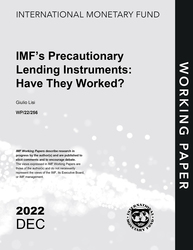
IMF’s Precautionary Lending Instruments: Have They Worked?
IMF’s Precautionary Lending Instruments: Have They Worked?
READ MORE...
Volume/Issue:
Volume 2022
Issue 256
Publication date: December 2022
ISBN: 9798400229626
$0.00
Add to Cart by clicking price of the language and format you'd like to purchase
Available Languages and Formats
| English |
Topics covered in this book
This title contains information about the following subjects.
Click on a subject if you would like to see other titles with the same subjects.
Finance , Economics- Macroeconomics , Money and Monetary Policy , Economics / General , IMF , Precautionary instruments , Event studies , Synthetic control , , PLL drawdown , precautionary lending instrument , fcl arrangement , precautionary instrument , PLL adopter , COVID-19 , Emerging and frontier financial markets , Oil prices , Credit default swap , Sovereign bonds , Global
Summary
The paper documents the benefits provided by IMF’s precautionary instruments (FCL and PLL) to countries in accessing international financial markets. It builds on multiple methods to show that the announcement of new FCL or PLL generally leads to a significant decline in sovereign spreads. Next, it evaluates the role of the FCL and PLL in mitigating external financial pressures, focusing on the COVID-19 pandemic as a case study. Economies which had a PLL or FCL arrangement in place during the pandemic experienced a lower increase in spreads relative to other emerging markets, even after controlling for country-specific effects and other covariates, suggesting that these arrangements help cushion external shocks. Finally, the study asks whether FCL/PLL drawdowns have an impact on financial perceptions; the analysis finds—albeit on the basis of a very small sample— no evidence of downside effects from countries drawing down on these arrangements .
Copyright © 2010 - 2025
Powered by:
AIDC



